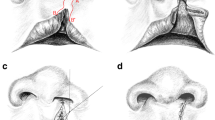Abstract
Patients and Methods: In this study the soft-tissue profile of 84 patients aged between 16 and 29 years after complete rehabilitation of a unilateral cleft of the lip, alveolus, and palate was compared on lateral cephalograms with that of 5 adult probands with no cleft formation.
Results and Conclusion: In the patient group, the thickness at nasion, the subnasal thickness, the upper alveolabial sulcus thickness, the upper lip prominence, and the mental thickness were less pronounced than in the control group. In contrast, the patients showed significantly higher values in the prominence and thickness of the lower lip. These results indicate a less dominant development of the upper lip and a more voluminous lower lip in comparison to the control group. In contrast, the length of the upper lip did not differ significantly between patients and controls. In both groups the facial integument was thicker in males than in females. The soft-tissue anb-angle, the soft-tissue Holdaway II angle, and the nasolabial angle were significantly smaller in the patients than in the controls. Furthermore, the patients showed a distinctly more concave soft-tissue profile than the controls in measurements of the soft-tissue convexity angle. Thus, it is important for all surgeons involved in the rehabilitation of these patients to pay attention not only to an adequate length of the cleft-sided upper lip, but also to attaining a physiological alignment and reconstruction of the muscles, since the orbicularis oris muscle represents the most important component in the form and function of the lip. In addition, discontinuous muscular slings in the facial area may lead to severe midface growth disturbances.
Zusammenfassung
Patienten und Methode: In dieser Arbeit wurde das Weichteilprofil von 84 Patienten im Alter zwischen 16 und 29 Jahren nach vollständiger Rehabilitation einer einseitigen Lippen-Kiefer-Gaumen-Spalte mit dem von 58 erwachsenen Probanden ohne Spaltbildungen im Fernröntgenseitenbild verglichen.
Ergebnisse und Schlussfolgerung: Die Nasiondicke, die subnasale Dicke, die Oberlippensulkusdicke, die Oberlippenrotprominenz und die mentale Dicke waren in der Gruppe der Spaltpatienten kleiner als in der Kontrollgruppe. Die Messungen der Unterlippenrotprominenz und der Unterlippendicke ergaben dagegen bei den Spaltpatienten signifikant größere Werte. Diese Befunde weisen auf eine weniger füllige Ausbildung der Oberlippe und eine voluminösere Unterlippe im Vergleich zur Kontrollgruppe hin. Die Länge der Oberlippe war bei den Spaltpatienten dagegen nicht signifikant verändert. Die faziale Weichgewebsdecke zeigte sich bei männlichen Vertretern sowohl den Spaltpatienten als auch der Kontrollgrupe dicker ausgeprägt als bei weiblichen. Der Weichgewebs-anb-Winkel, der Holdaway-II-Winkel und der Nasolabialwinkel waren bei den Spaltpatienten signifikant kleiner als in der Kontrollgruppe und bei der Bestimmung des Gesichtsprofils durch den Weichgewebskonvexitätswinkel wiesen die Spaltpatienten ein deutlich konkaveres Weichteilprofil auf als die Probanden der Kontrollgruppe. Es sollte somit für alle an der Rehabilitation der Spaltpatienten beteiligten Behandler ein besonderes Anliegen sein, schon beim Lippenverschluss nicht nur auf eine ausreichende Länge, der spaltseitigen Oberlippe zu achten, sondern auch eine physiologische Ausrichtung und Vereinigung der Muskulatur zu erreichen, da der Musculus orbicularis oris für Form und Funktion im Lippenbereich die wichtigste Grundlage bildet und die unterbrochenen Muskelschlingen im Bereich des Gesichtes zu schwerwiegenden Wachstumsstörungen des Mittelgesichtes führen können.
Similar content being viewed by others
Author information
Authors and Affiliations
Additional information
Received: May 29, 2001; accepted: December 12, 2001
Rights and permissions
About this article
Cite this article
Stoll, C., Opitz, C., Bauer, S. et al. The Soft-Tissue Facial Profile of Patients with Unilateral Clefts of the Lip, Alveolus, and Palate Compared with Healthy Adults. Journal of Orofacial Orthopedics / Fortschritte der Kieferorthopädie 63, 179–189 (2002). https://doi.org/10.1007/s00056-002-0114-5
Published:
Issue Date:
DOI: https://doi.org/10.1007/s00056-002-0114-5



